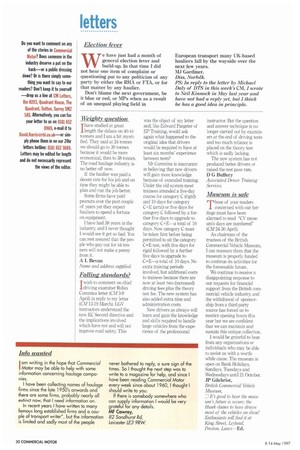Falling standards?
Page 32

If you've noticed an error in this article please click here to report it so we can fix it.
Iwish to comment on chief driving examiner Robin Cummins letter (CM 3-9 April) in reply to my letter (CM 13-19 March). WV instructors understand the new EC Second directive and the implications involved which have not and will not improve road safety. This
was the object of my letter and. like Edward Pargeter of EP Training, would ask again what happened to the original idea that drivers would be required to have at least six months' experience between tests?
Mr Cummins is inaccurate in believing that new drivers will gain more knowledge because of extended training. Under the old system most trainees attended a five-day course for category C (rigid) and 10 days for category C+E (artic) or five days for category C followed by a further five days to upgrade to category C+E—a total of 10 days. Now category C must be taken first before being permitted to sit the category C+E test, with five days for rigid followed by a further five days to upgrade to C+E—a total of 10 days. No extra training periods involved, but additional costs to trainees because there are now at least two (increased) driving fees plus the theory test fee. The new system has also added extra time and administration costs New drivers as always will learn and gain the knowledge and skills required to handle large vehicles from the experience of the professional instructor. But the question and answer technique is no longer carried out by examiners at the end of driving tests and too much reliance is placed on the theory test which is sadly lacking.
The new system has not produced better drivers or raised the test pass rate. D G Buffery Associated Driver Training Services.




























































































































